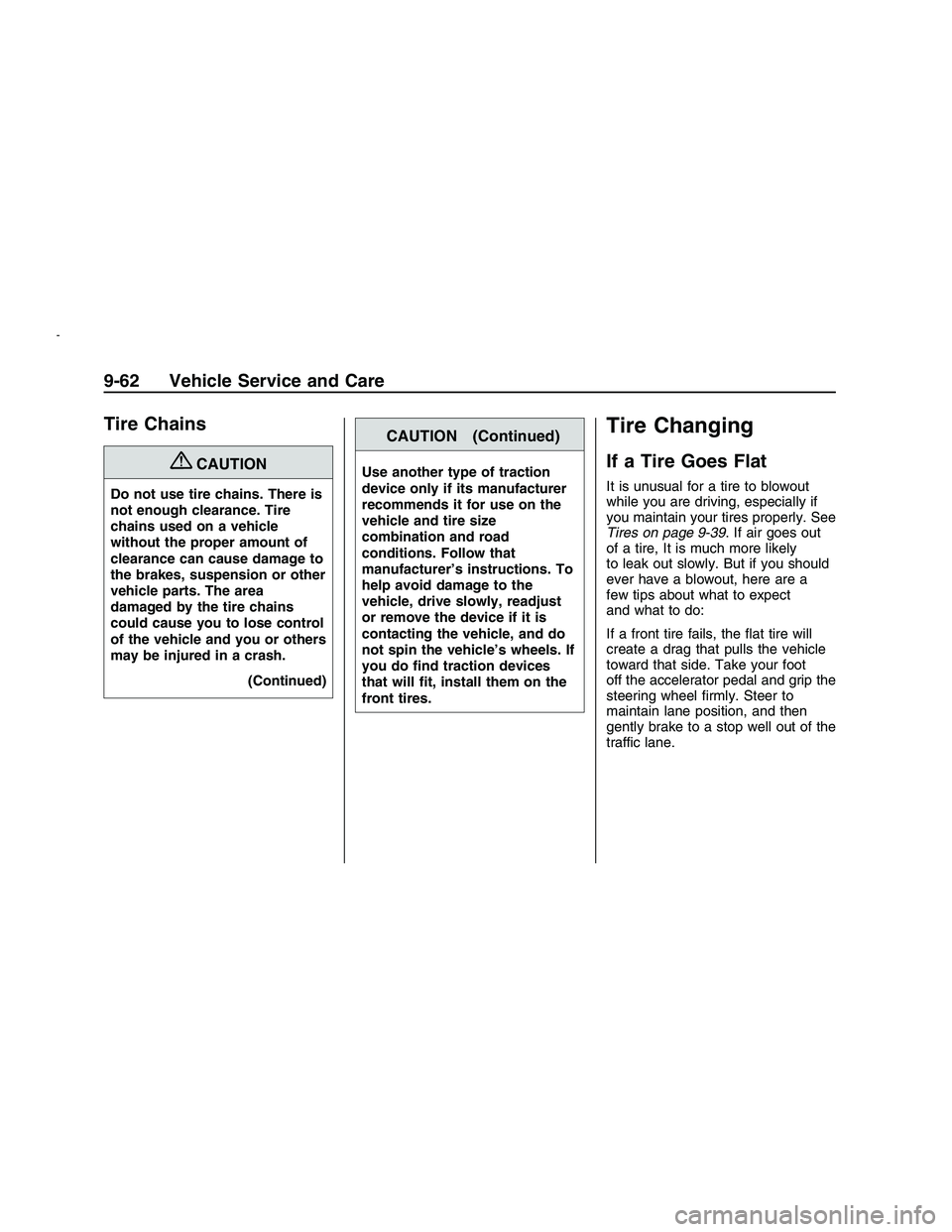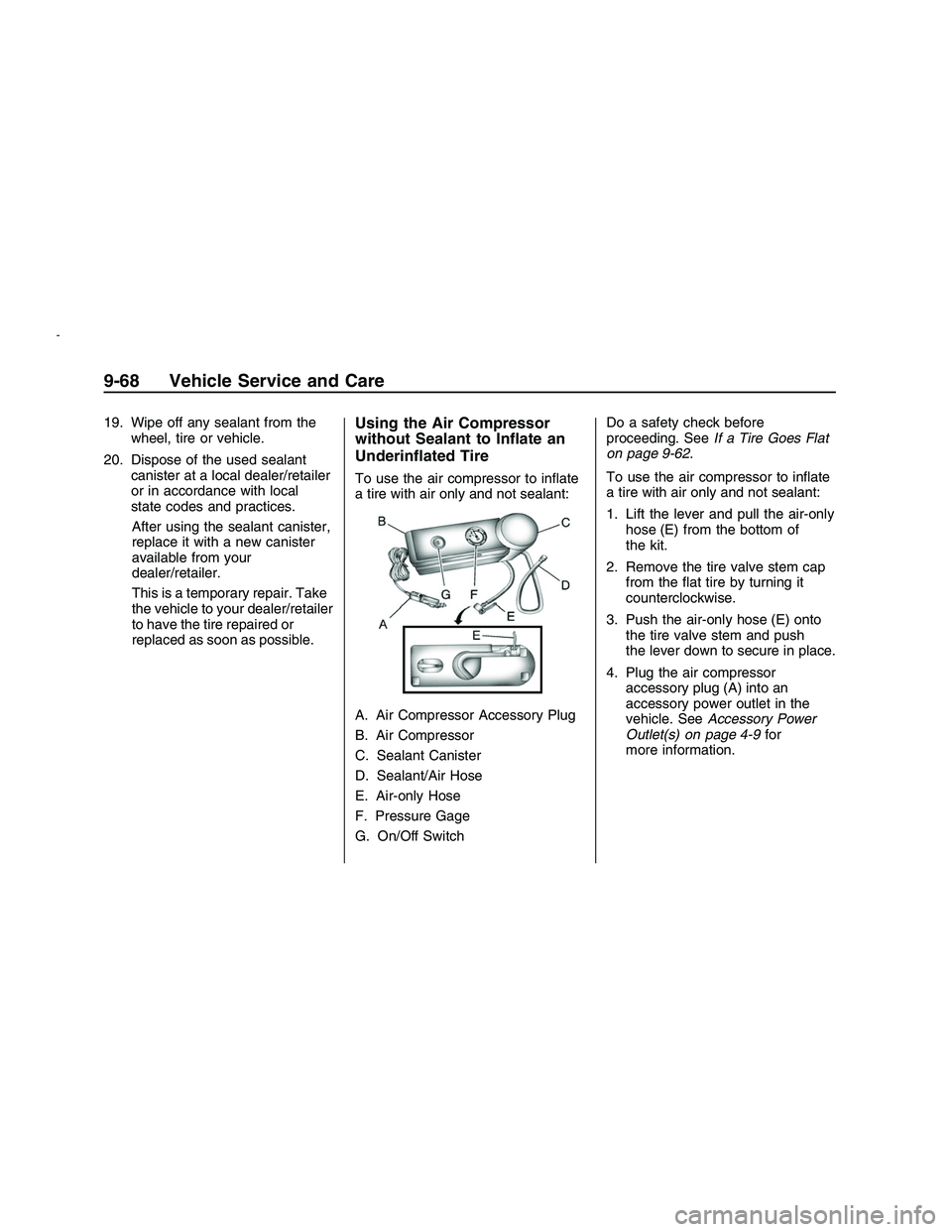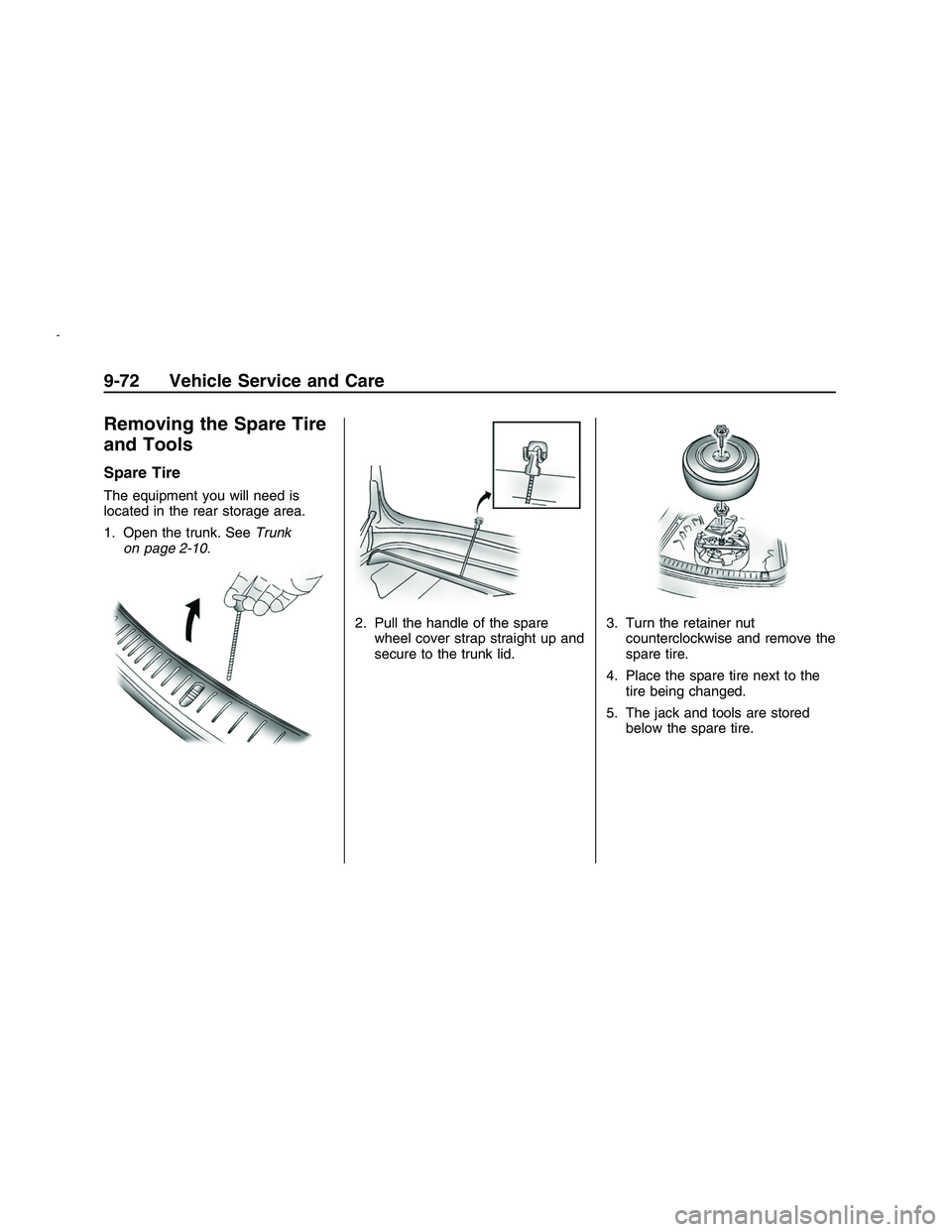2008 PONTIAC G8 wheel
[x] Cancel search: wheelPage 245 of 334

the alignment might need to be
checked. If you notice your vehicle
vibrating when driving on a
smooth road, the tires and wheels
might need to be rebalanced.
See your dealer/retailer for proper
diagnosis.
Wheel Replacement
Replace any wheel that is bent,
cracked or badly rusted or corroded.
If wheel nuts keep coming loose,
the wheel, wheel bolts and
wheel nuts should be replaced. If
the wheel leaks air, replace it
(except some aluminum wheels,
which can sometimes be repaired).
See your dealer/retailer if any of
these conditions exist.
Your dealer/retailer will know the
kind of wheel you need.
Each new wheel should have the
same load-carrying capacity,
diameter, width, offset and be
mounted the same way as the one
it replaces.If you need to replace any of the
wheels, wheel bolts or wheel
nuts, replace them only with new
GM original equipment parts.
This way, you will be sure to have
the right wheel, wheel bolts and
wheel nuts for the vehicle.
{CAUTION
Using the wrong replacement
wheels, wheel bolts, or wheel
nuts on your vehicle can be
dangerous. It could affect the
braking and handling of your
vehicle, make your tires lose air
and make you lose control. You
could have a collision in which
you or others could be injured.
Always use the correct wheel,
wheel bolts, and wheel nuts for
replacement.Notice:The wrong wheel can
also cause problems with bearing
life, brake cooling, speedometer
or odometer calibration,
headlamp aim, bumper height,
vehicle ground clearance, and tire
or tire chain clearance to the
body and chassis.
SeeChanging a Flat Tire (V6
Engine) on page 9-71for more
information.
Used Replacement Wheels
{CAUTION
Putting a used wheel on the
vehicle is dangerous. You
cannot know how it has been
used or how far it has been
driven. It could fail suddenly
and cause a crash. If you have
to replace a wheel, use a new
GM original equipment wheel.
Vehicle Service and Care 9-61
2008 - Pontiac G8 Owner Manual
Page 246 of 334

Tire Chains
{CAUTION
Do not use tire chains. There is
not enough clearance. Tire
chains used on a vehicle
without the proper amount of
clearance can cause damage to
the brakes, suspension or other
vehicle parts. The area
damaged by the tire chains
could cause you to lose control
of the vehicle and you or others
may be injured in a crash.
(Continued)
CAUTION (Continued)
Use another type of traction
device only if its manufacturer
recommends it for use on the
vehicle and tire size
combination and road
conditions. Follow that
manufacturer’s instructions. To
help avoid damage to the
vehicle, drive slowly, readjust
or remove the device if it is
contacting the vehicle, and do
not spin the vehicle’s wheels. If
you do �nd traction devices
that will �t, install them on the
front tires.
Tire Changing
If a Tire Goes Flat
It is unusual for a tire to blowout
while you are driving, especially if
you maintain your tires properly. See
Tires on page 9-39. If air goes out
of a tire, It is much more likely
to leak out slowly. But if you should
ever have a blowout, here are a
few tips about what to expect
and what to do:
If a front tire fails, the �at tire will
create a drag that pulls the vehicle
toward that side. Take your foot
off the accelerator pedal and grip the
steering wheel �rmly. Steer to
maintain lane position, and then
gently brake to a stop well out of the
traffic lane.
9-62 Vehicle Service and Care
2008 - Pontiac G8 Owner Manual
Page 247 of 334

A rear blowout, particularly on a
curve, acts much like a skid
and may require the same correction
you would use in a skid. In any
rear blowout, remove your foot from
the accelerator pedal. Get the
vehicle under control by steering the
way you want the vehicle to go. It
may be very bumpy and noisy,
but you can still steer. Gently brake
to a stop, well off the road if
possible.
If a tire goes �at, and your vehicle
has a compact spare tire, see
Changing a Flat Tire (V6 Engine) on
page 9-71. This information shows
you how to use the vehicle’s
tire changing equipment and how to
change a �at tire safely.{CAUTION
Lifting a vehicle and getting
under it to do maintenance or
repairs is dangerous without the
appropriate safety equipment
and training. The jack provided
with your vehicle is designed
only for changing a �at tire. If it
is used for anything else, you or
others could be badly injured or
killed if the vehicle slips off the
jack. Use the jack provided with
your vehicle only for changing a
�at tire.
Tire Sealant and
Compressor Kit
If your vehicle has a factory installed
Tire Sealant and Compressor kit,
there is no spare tire, no tire
changing equipment and no place to
store a tire.If a tire goes �at, avoid further tire
and wheel damage by driving slowly
to a level place and stopping.
1. Turn on the hazard warning
�ashers. SeeHazard Warning
Flashers on page 4-4.
2. Park your vehicle. Set the
parking brake �rmly and put the
shift lever in PARK (P). See
Shifting Into Park (Automatic
Transmission) on page 8-10.
3. Turn off the engine.
4. Inspect the �at tire.
If the tire has been separated from
the wheel, has damaged sidewalls,
or has a puncture larger than a
1�4inch (6 mm), the tire is too
severely damaged for the tire
sealant and compressor kit to be
effective. SeeRoadside Assistance
Program on page 12-6.
If the tire has a puncture less than a
1�4inch (6 mm) in the tread area
of the tire, seeTire Sealant
and Compressor Kit (V8 Engine) on
page 9-64.
Vehicle Service and Care 9-63
2008 - Pontiac G8 Owner Manual
Page 248 of 334

Tire Sealant and
Compressor Kit
(V8 Engine)
This vehicle has a tire sealant and
compressor kit in place of a jack or
spare tire. It is located in a foam
container in the trunk. The tire
sealant and compressor kit can be
used to repair a �at tire by sealing
small punctures in the tread of the
tire. It can also be used to in�ate an
underin�ated tire. The vehicle must
be driven for �ve miles (8 kilometers)
after the tire is sealed and in�ated to
the recommended pressure to
ensure the sealant is distributed
evenly. For detailed instructions see
“Using the Tire Sealant and
Compressor Kit to Temporarily
Repair a Punctured Tire” later in this
section.The kit includes:
A. On/Off Switch
B. Air Compressor Accessory Plug
C. Air Compressor
D. Sealant Canister
E. Sealant/Air Hose
F. Air-only Hose
G. Pressure Gage
Tire Sealant
The sealant can temporarily seal a
small puncture up to 6 mm in
the tread area of the tire. The
sealant cannot seal sidewall
damage, large punctures, or a wheel
that has unseated from the wheel.
Read and follow the safe handling
instructions on the label adhered to
the sealant canister.
Check the tire sealant expiration
date on the sealant canister.
The sealant canister should be
replaced before its expiration date.
There is only enough sealant to
seal one tire. After usage, the
sealant canister and sealant/air hose
assembly must be replaced.
Replacement sealant canisters are
available from a dealer/retailer.
See “Removal and Installation of
Sealant Canister” later in this
section.
9-64 Vehicle Service and Care
2008 - Pontiac G8 Owner Manual
Page 249 of 334

Using the Tire Sealant and
Compressor Kit to
Temporarily Seal and In�ate a
Punctured Tire
Follow these directions closely for
correct sealant usage.
A. On/Off Switch
B. Air Compressor Accessory Plug
C. Air Compressor
D. Sealant Canister
E. Sealant/Air Hose
F. Air-only Hose
G. Pressure GageDo a safety check before
proceeding. SeeIf a Tire Goes Flat
on page 9-62.
Inspect the damaged tire.
The sealant cannot seal sidewall
damage, large punctures, or a
tire that has unseated from
the wheel. SeeRoadside Assistance
Program on page 12-6.
Do not remove any objects that
have penetrated the tire.
1. Place the tire sealant and
compressor kit on the ground and
unwrap the sealant/air hose (E)
from the side of the compressor.
2. Remove the air compressor
accessory plug (B) from the unit.
Do not plug the plug in yet.
3. Turn the tire valve stem cap
counterclockwise to remove.
4. Attach the sealant/air hose (E)
onto the tire valve stem. Turn
it clockwise until tight.5. Make sure the sealant and
compressor kit on/off switch (A) is
in the O (off) position.
Plug the air compressor
accessory plug (B) into an
accessory power outlet in the
vehicle. SeeAccessory Power
Outlet(s) on page 4-9for
more information.
Do not slam door or close
window on the compressor
accessory plug cord.
{CAUTION
Idling the engine in a closed-in
place or with the climate
control system off can cause
deadly carbon monoxide (CO).
SeeEngine Exhaust on
page 8-12.
6. Start the vehicle. The vehicle
must be running while using
the air compressor.
Vehicle Service and Care 9-65
2008 - Pontiac G8 Owner Manual
Page 252 of 334

19. Wipe off any sealant from the
wheel, tire or vehicle.
20. Dispose of the used sealant
canister at a local dealer/retailer
or in accordance with local
state codes and practices.
After using the sealant canister,
replace it with a new canister
available from your
dealer/retailer.
This is a temporary repair. Take
the vehicle to your dealer/retailer
to have the tire repaired or
replaced as soon as possible.Using the Air Compressor
without Sealant to In�ate an
Underin�ated Tire
To use the air compressor to in�ate
a tire with air only and not sealant:
A. Air Compressor Accessory Plug
B. Air Compressor
C. Sealant Canister
D. Sealant/Air Hose
E. Air-only Hose
F. Pressure Gage
G. On/Off SwitchDo a safety check before
proceeding. SeeIf a Tire Goes Flat
on page 9-62.
To use the air compressor to in�ate
a tire with air only and not sealant:
1. Lift the lever and pull the air-only
hose (E) from the bottom of
the kit.
2. Remove the tire valve stem cap
from the �at tire by turning it
counterclockwise.
3. Push the air-only hose (E) onto
the tire valve stem and push
the lever down to secure in place.
4. Plug the air compressor
accessory plug (A) into an
accessory power outlet in the
vehicle. SeeAccessory Power
Outlet(s) on page 4-9for
more information.
9-68 Vehicle Service and Care
2008 - Pontiac G8 Owner Manual
Page 255 of 334

Changing a Flat Tire
(V6 Engine)
If a tire goes �at, avoid further tire
and wheel damage by driving slowly
to a level place. Turn on the
hazard warning �ashers.
{CAUTION
Changing a tire can be
dangerous. The vehicle can slip
off the jack and roll over or fall
on you or other people. You
and they could be badly injured
or even killed. Find a level
place to change your tire. To
help prevent the vehicle from
moving:
1. Set the parking brake
�rmly.
2. Put the shift lever in
PARK (P).
(Continued)
CAUTION (Continued)
3. Turn off the engine and do
not restart while the
vehicle is raised.
4. Do not allow passengers to
remain in the vehicle.
To be certain the vehicle will
not move, put blocks at the
front and rear of the tire
farthest away from the one
being changed. That would be
the tire on the other side, at the
opposite end of the vehicle.When you have a �at tire, use the
following example as a guide to
assist you in the placement of wheel
blocks.
Vehicle Service and Care 9-71
2008 - Pontiac G8 Owner Manual
Page 256 of 334

Removing the Spare Tire
and Tools
Spare Tire
The equipment you will need is
located in the rear storage area.
1. Open the trunk. SeeTrunk
on page 2-10.
2. Pull the handle of the spare
wheel cover strap straight up and
secure to the trunk lid.3. Turn the retainer nut
counterclockwise and remove the
spare tire.
4. Place the spare tire next to the
tire being changed.
5. The jack and tools are stored
below the spare tire.
9-72 Vehicle Service and Care
2008 - Pontiac G8 Owner Manual